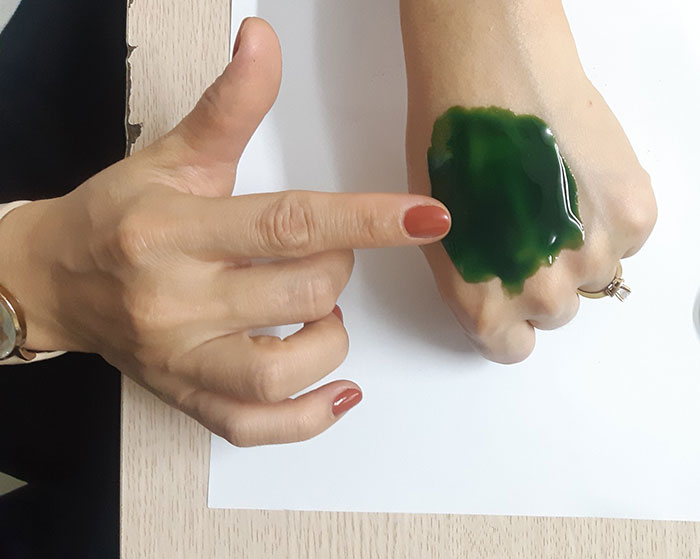Microalgae are photosynthetic organisms that produce valuable metabolites when exposed to adverse, stressful conditions such as high or low temperature, high salinity, osmotic pressure, photochemical processes, radiation, etc. ultraviolet radiation. These valuable metabolites have attracted the attention of cosmetics and makeup industry researchers for use in anti-aging, sunscreen, and skin-whitening products. Microalgae secondary metabolites may have anti-acne or anti-bacterial effects; It can also repair and heal the skin, protect it from UV damage and prevent inflammation. Existing cosmetic products can be replaced by microalgae-based cosmetic products that are environmentally friendly and safe, making them publicly important because people want the products. as natural as possible. Currently several products derived from microalgae have been marketed and the biotechnology of microalgae is growing more and more every day which will produce more commercial products in a short time. This review highlights the potential of microalgae species and their derived bioactive molecules in popular natural cosmetics with a particular focus on areas of application and production steps. cosmetics production.

Microalgae are a group of eukaryotic microorganisms capable of photoautotrophs that are diverse in composition and number of species. Microalgae vary in size (0.2 μm to even larger than 70 mm), and vary in structure and shape. Cyanobacteria, also known as cyanobacteria, are often thought of as microalgae even though they are bacteria. The highly diverse cyanobacteria are the first group of oxygen-producing photosynthetic organisms, Gram negative, capable of surviving in most habitats such as marine, freshwater, soil, crust, mountains, snow, water salty, hot water. Microalgae are often exposed to extreme conditions such as UV radiation and high salinity because they also live in harsh environments, so to survive and thrive, they must have some mechanism to combat these conditions. conditions of UV radiation, reactive oxygen species and free radicals.
Microalgae produce compounds to protect themselves, and these compounds have attracted the attention of the cosmetic industry. Compounds from microalgae can be converted into potential products to be used in cosmetic or make-up products, especially to protect skin from sun damage. These bioactive compounds may include polyunsaturated fatty acids (PUFAs), chlorophyll (chlorophyll), carotenoids and phycobiliproteins, carbohydrates, proteins, peptides, amino acids, vitamins, polyphenols, phytosterols. These compounds have various effects such as antioxidant, antitumor, antibacterial, antiviral and antifungal activities and immunostimulatory effects. In addition, compounds from microalgae with anti-inflammatory effects modulate macrophage function to maintain homeostasis in the tissue immune system. The most obvious effects were antioxidant activity, superoxide radical scavenging, hydroxyl radical scavenging, 1,1-diphenyl-2-picrylhydrazyl radical scavenging (DPPH), thi-obarbituric acid (TBA), ferric thiocyanate (FTC), 2, 20-azinobis-3-ethylbenzothizoline-6-sulfonate (ABTS), atomic oxygen quenching and lipid peroxide inhibitory activity. Through many studies, microalgae have high antioxidant activity because metabolites extracted from microalgae or bioactive compounds derived from microalgae have great potential to become bioactive products. new bio-based products such as cosmetics, pharmaceuticals, nutrients, bioplastics and biofilm forming agents.
Microalgae synthesize secondary metabolites with anti-inflammatory, anti-acne or anti-bacterial effects. The compounds also work to repair and heal the skin and prevent inflammation. For example, spirulina Arthrospira platensis is rich in protein (50-70%), which can be used as a bioactive compound to repair skin aging and prevent wrinkle formation. Chlorella vulgaris extract can enhance collagen synthesis in the skin, support skin tissue and promote the regeneration of new tissue. Dunaliella salina algae extract stimulates cell growth and also improves energy metabolism. C. vulgaris, Nostoc and A. platensis produce high levels of chlorophyll and carotenoids, which have antioxidant properties, in the presence of UV radiation. Silica Odontella aurita produces important fatty acids such as PUFAs, saturated fatty acids (SFAs), monounsaturated fatty acids (MUFAs), eicosapentaenoic acid (EPA), docosahexaneoic acid (DHA). Some components of the microalgae extract react with various proteins on the skin to form a protective gel on the surface of the skin, preventing moisture loss. In addition, some microalgae have the ability to maintain the balance of skin flora through protection from microorganisms such as Synechocystis sp. showed high antibacterial activity against Escherichia coli, Candida albicans, Staphylococcus aureus and Aspergillus niger.
As such, the potential uses of microalgae are promising and their valuable products in cosmetics, how they can be used in anti-aging, sunscreen and skin whitening products, as well as as a way to produce and purify microalgae metabolites from the laboratory to the large scale.
